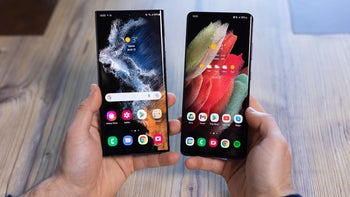Samsung didn't upgrade the Galaxy S22 Ultra's OLED display generation this time
We may earn a commission if you make a purchase from the links on this page.

On first read, the Galaxy S22 Ultra specs sound like it sports Samsung's newest, M12 generation of LTPO OLED displays compared to what's on the Galaxy S21 Ultra. Last year's Samsung flagship uses an M11 generation of OLED materials but the record 1750 nits brightness and the new 1Hz-120Hz adaptive refresh rate range could've austensibly meant a next-gen OLED tech is inside.
That's not the case, reports The Elec, as the Galaxy S22 Ultra uses the same M11 OLED material whose potential has however been exploited to the max by Samsung to reach those sky high S22 Ultra display specs like a record peak display brightness of 1750 nits or the most granular 1Hz-120Hz refresh rate dynamics. The S22+, however, which last year used the M10 material, now gets upgraded to M11, and only the S22 display stays at the M10 generation
Granted, such brightness levels will only be possible when you are watching HDR content in high ambient light settings, yet the same requirements are valid for the S21 Ultra's panel which is able to reach "just" 1500 nits.
Granted, such brightness levels will only be possible when you are watching HDR content in high ambient light settings, yet the same requirements are valid for the S21 Ultra's panel which is able to reach "just" 1500 nits.
The rest of the Galaxy S22 Ultra display quality benchmarks that we tested are also superior to what the S21 Ultra musters. The newer panel exhibits a more credible color temperature representation that is closer to the reference white point instead of appearing slightly colder and blueish. Both the standard and the wide color gamut coverage of the S22 Ultra are also tighter and better aligning to the reference points meaning that what you see on the display is what you get with your own eyes to a larger extent than on the S21 Ultra.
The more granular refresh rate control down to the single hertz hence means more efficient display power consumption, too, at least on paper, as in reality the S22 Ultra didn't fair better than the S21 Ultra in our battery tests. Both screens have active digitizer layers that allow them to react to Samsung's S Pen, with the big difference that on the S22 Ultra the stylus is always in the phone, while the S21 Ultra has it as a tack-on in a separate (and unwieldy) case.
When we add the drastically decreased input lag of the new S Pen stylus and the higher WACOM digitizer sensitivity for handwriting, it's another win for the S22 Ultra here despite that it uses the same generation OLED material that is in the S21 Ultra.
















Things that are NOT allowed: